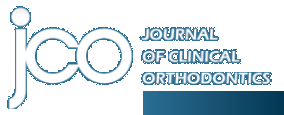Search Results For: 'orthodontics'
3741.
PEARLS
A Simplified Method of Correcting Single-Tooth Crossbite
Volume 50 : Number 7 : Page 0 : Jul 2016
Every orthodontist needs to be equipped with methods for providing limited interceptive care. In this month's Pearl, the authors share a simple composite build-up technique to correct a traumatic ante...
3742.
Product News in September 2020 Issue
Volume 54 : Number 9 : Page 570 : Sep 2020
PRODUCT NEWS is presented as a service to the reader and in no way implies endorsement by JCO.
3743.
PEARLS
Correction of Occlusal-Plane Cant Using Spee-Anti-Spee Wires
Volume 58 : Number 5 : Page 289 : May 2024
A canted occlusal plane is a challenging problem that can affect facial esthetics. In this Pearl, after initial leveling and alignment, rectangular TMA archwires are configured with Spee and anti-Spee bends on opposite sides to compensate for the cant.
3744.
Product News in May 2024 Issue
Volume 58 : Number 5 : Page 322 : May 2024
PRODUCT NEWS is presented as a service to the reader and in no way implies endorsement by JCO.
3745.
Clinical Considerations in the Use of Retraction Mechanics
Volume 25 : Number 6 : Page 0 : Jun 1991
Once a decision to extract teeth has been made, the orthodontist must plan how to close any space that is not devoted to relief of crowding. Whether anterior retraction, posterior protraction, or a co...
3746.
JCO Interviews Dr. G. Herbert Hanson on the SPEED Bracket
Volume 20 : Number 3 : Page 0 : Mar 1986
DR. WHITE Why did you feel the profession needed a new bracket? DR. HANSON Twenty-five years ago, when I first observed bracket ligation with wires, it impressed me as being a very cumbersome and unpl...
3747.
Diagnostic Block Cephalometrics, Part 1
Volume 18 : Number 6 : Page 400 : Jun 1984
Cephalometrics has been called a "numbers game" and a search for "sacred numbers" that would dictate a consistently reliable analysis. This search has proven futile, since all cephalometric measuremen...
3748.
A Simplified Approach to Demanding Anchorage Cases
Volume 2 : Number 7 : Page 0 : Sep 1968
Treatment of Class II malocclusions varies almost from year to year. A questionnaire to ten different orthodontists in ten different sections of the country would probably reveal ten different approac...
3749.
Datamedic: A Computer Billing System
Volume 8 : Number 10 : Page 562 : Oct 1974
I suppose there are a lot of orthodontists who, like myself, have recognized the need for some form of automated billing system. The problem is in finding the one that is right for a particular practi...
3750.
Volume 27 : Number 1 : Page 0 : Jan 1993
The topics include functional appliances and employee evaluations.1. In what percentage of your cases do you use functional appliances? Seventy-three percent of the readers reported using functional a...
3751.
The Geometry of Class II Correction with Extractions
Volume 35 : Number 9 : Page 570 : Sep 2001
Notwithstanding the criticism of today's nonextraction advocates, the extraction of teeth often results in more realistic treatment plans, better therapy, and superior function.1 For some patients, th...
3752.
THE READERS' CORNER
Non-Compliance Appliances and Fee Payments
Volume 38 : Number 4 : Page 211 : Apr 2004
Do you use non-compliance appliances? Seventy percent of the clinicians reported that they "sometimes" used non-compliance devices;8% "always" used them, and 3% "never" used them. Under what circumsta...
3753.
JCO Interviews Dr. Homer W. Phillips on Bonding, Part 1
Volume 14 : Number 6 : Page 391 : Jun 1980
DR. GOTTLIEB Do you think that bonding has arrived as a substitute for orthodontic banding?DR. PHILLIPS I definitely do. Many simple everyday things that we take for granted have evolved because someo...
3754.
Success and Failure with the Positioner Appliance Report of 100 Cases
Volume 2 : Number 10 : Page 0 : Dec 1968
506-jco-img-0.jpgThe Tooth Positioner Appliance was originated by Dr. Harold Kesling of Westville, Indiana. The profession is indebted to Dr. Kesling for its development and for many of the refinement...
3755.
Volume 13 : Number 7 : Page 439 : Jul 1979
In November of 1978, the voters in Oregon with a 78% affirmative vote passed an initiative to license and regulate denturists. Dental laboratory technicians, dealing directly with the public in Oregon...
3756.
A New Approach to Staying on Time
Volume 26 : Number 6 : Page 0 : Jun 1992
Running on time is a primary concern in my practice, as it is for most orthodontists. It seems that the farther behind we are, the higher the frustration level becomes throughout the office. Patients ...
3757.
LETTERS
Volume 30 : Number 10 : Page 0 : Oct 1996
I was very interested to read the recent Case Report, "Treatment of Adult Midline Deviation by Condylar Repositioning", by Dr. Fred Schudy (JCO, June 1996). I feel compelled to respond for a number of...
3758.
THE EDITOR'S CORNER
Volume 32 : Number 6 : Page 345 : Jun 1998
Although several authors have recently explored the concept of the placebo,1-3 there is scant evidence that dentists generally or orthodontists specifically have given much heed to the topic, apart fr...
3759.
Volume 22 : Number 9 : Page 0 : Sep 1988
The dynamic and static positions of the functioning mandible are primarily determined by six factors: 1. The functional program of the neuromuscular system and the influence of proprioceptivity. 2. Th...
3760.
MANAGEMENT & MARKETING
Volume 27 : Number 11 : Page 0 : Nov 1993
This month's column is a follow-up to Dr. Roger Levin's article on team building (JCO, August 1993). Although it is the first contribution I have used from anyone other than a dentist, it was inspired...
Showing 3741-3760 of 4092 results. Search completed in 0.118 seconds.

